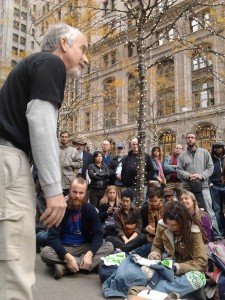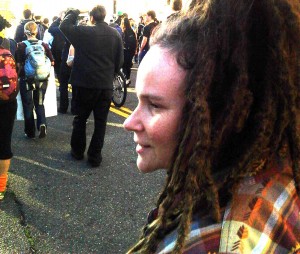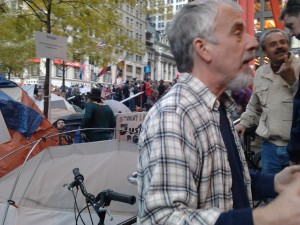Recircle Your Wagons: Buy Ins and Outcomes along the Occupy Highway
Now well into our second month of our official tour, C.T. and I are starting to revisit some Occupy sites and deepen our relationships with protesters as they try new meeting skills.
One of the paradigm shifts we are teaching is to avoid being outcome oriented. Consensus really blossoms when we’re not attached to a particular solution, but instead curious what ideas the discussion will bring.
So I have to laugh at myself when I look at our teaching in terms of outcomes—Are we making a difference? Are facilitators and other activists learning real tools they can and do use? Are these tools helping all voices to be heard?
In short, yes. We can see differences in working group meetings, GA’s, and even online discussions. Folks in Chico were able to structure their GA better and handle disruptors. They went from one person planning the agenda five minutes in advance to a team having a real agenda planning meeting. Some Occupy Chico members who hadn’t attended our Consensus: Body & Soul workshop accused us of being some kind of cult, but workshop participants were articulate about how consensus really is about all voices being heard.
Occupy folks who attend our talks or meet with us at length get these very intense looks on their faces as the gravity of the paradigm shifts lands on them. They take in the bombshells that C.T. volleys at them:
- A group is by definition not everybody. Inclusion is not about letting everybody in, no matter what drugs they’re on or how they behave. Rather inclusion is creating a safe container by enforcing expectations of behavior and making space for everyone willing to participate in making that safe container. No rulers, not no rules.
- It’s actually easier to change the behavior of the entire group toward a disruptor than change the behavior of the disruptor. Recircle your wagons! If a person won’t stop shouting, have everyone turn away. Even if the facilitators have to end the meeting, you’ve done a better job of creating safe space for the future than if you let someone disrupt.
- “If war is the violent resolution of conflict, then peace is not the absence of conflict, but rather the ability to resolve conflict without violence.” —C.T. Lawrence Butler, On Conflict and Consensus
- When you have competitive and cooperative people in the same group, the competitive people always win. There are two reasons: 1) The competitive people are trying to win, and 2) The cooperative people are trying to help them! Duh!
The list goes on, lesson after lesson, laid down at encampment after encampment. It’s not exactly a look of shock that repeats across the faces. It’s more the weight, the opening of the mind, the realization that the original OWS template created many of these problems. And turning it around seems impossible. But it’s not.
Recircle Your Wagons!
Organic change can happen in the Occupy movement without trying to sell a GA hijacked by angry disruptors on the idea of a better structured direct democracy.
 If you’d like to see a movement with a clarified, mature understanding of inclusion, a movement based on true consensus (not voting in disguise), a movement that is making the paradigm shifts that go along with cooperation, then start with an affinity group.
If you’d like to see a movement with a clarified, mature understanding of inclusion, a movement based on true consensus (not voting in disguise), a movement that is making the paradigm shifts that go along with cooperation, then start with an affinity group.
Form an affinity group around these ideas. The membership is not open to whoever finds out about the meeting place and shows up, the membership is defined by common values and interests. Your group could be the  food working group or a group just established to study consensus together. It doesn’t matter. You’re not working outside of the Occupy structure. You’re not splitting off. You’re an affinity group. You don’t need permission to exist. If this group succeeds in getting work done without the drama people see in GA’s, word will spread. Best practices will spread. Let it go viral.
food working group or a group just established to study consensus together. It doesn’t matter. You’re not working outside of the Occupy structure. You’re not splitting off. You’re an affinity group. You don’t need permission to exist. If this group succeeds in getting work done without the drama people see in GA’s, word will spread. Best practices will spread. Let it go viral.




Leave a Reply
You must be logged in to post a comment.